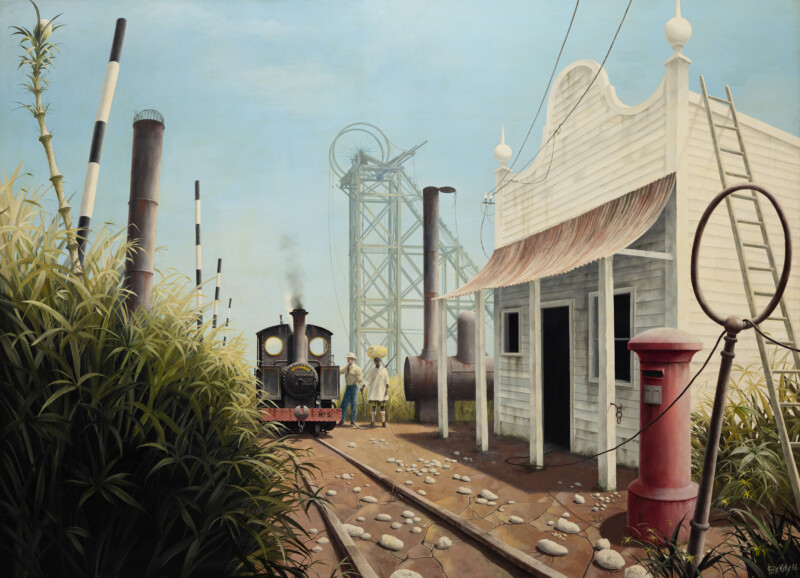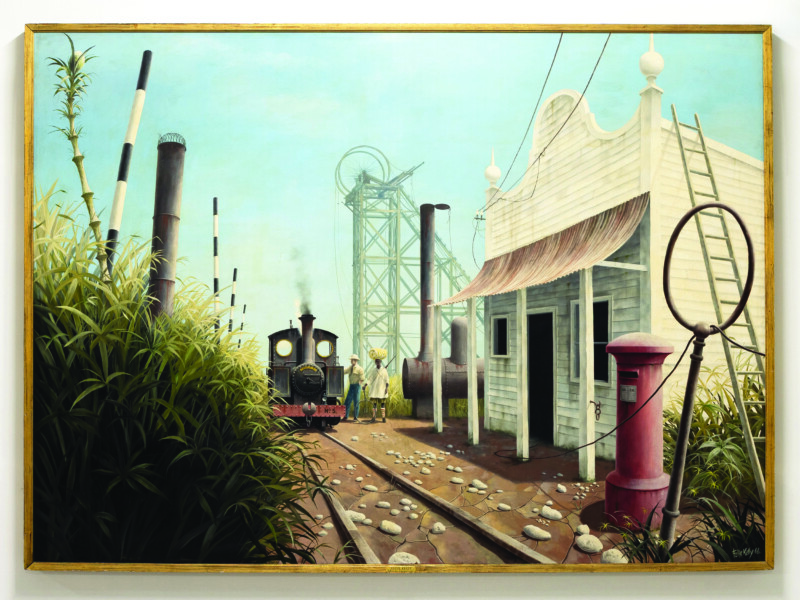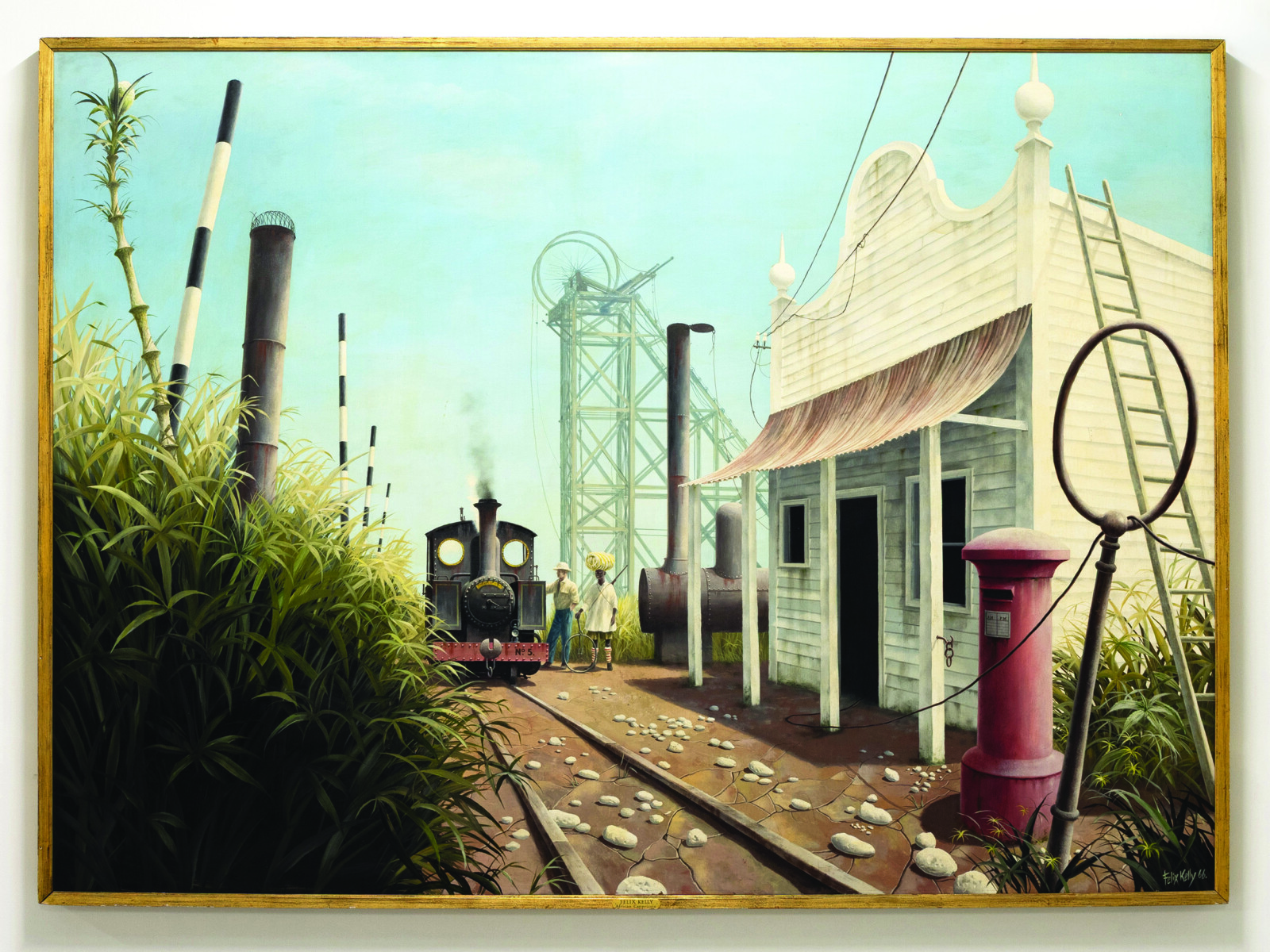KELLY, Felix;
African Capriccio
1966
Oil on board
1670 x 2330mm


Felix Runcie Kelly was born in 1914 in Tāmaki Makaurau and spent his youth in the city. In 1935, aged 21, he relocated to the United Kingdom, joining his mother, Hortense, who had moved there some time earlier.[1] He set about establishing himself as a commercial and fine artist. Donald Bassett, the leading scholar on his work, has commented: ‘He needed to get away. In London he found greater social and sexual acceptance [as a gay man] in the anonymity of a big city, and the cultural richness Europe offered eclipsed anything he had experienced here. Europe fed the dreams nurtured by his typically Eurocentric education.’[2] Bassett has also noted that Kelly has historically been overlooked in Aotearoa. But today his reputation is growing. He is increasingly recognised as a key ‘expatriate’, alongside figures like Frances Hodgkins.
Kelly created a plethora of paintings and sketches, typically immaculate in their rendering, as well as advertisements, book and magazine illustrations, murals, and stage set designs. His works often feel bizarre, macabre, uncanny, or whimsical, showing the influence of diverse artistic movements, including surrealism and neo-romanticism. Kelly had an eclectic eye, and took pleasure in bringing together diverse and incongruous forms in his pictures. He had an enthusiasm for architecture from Britain and abroad (among his works are numerous portrayals of English grand houses commissioned by their wealthy owners), and for transportational and industrial structures and machines, especially outmoded ones. He travelled extensively, gathering source material during his excursions.
In 1956, Kelly was commissioned to visit West Africa by owners of diamond mines in Sierra Leone and Ghana (then known as the Gold Coast).[3] He subsequently produced six paintings for their London boardroom. The uncommonly grand African Capriccio was painted following a second West African trip made in 1965. As the title suggests, the work is a ‘capriccio’, a picture that fancifully relocates real-world elements, or combines real-world elements with imagined ones.[4] The overall scene has been invented by Kelly, but most of the entities depicted were presumably observed by him in West Africa. The central building is a post office from Sierra Leone, as evidenced by a closely related but much smaller painting from 1967 called Post Office, Sierra Leone.[5] Old-fashioned steam locomotives, imported from Britain, were in use in the country.[6] The lofty headframe shown in the background evokes shaft mining.
African Capriccio is an altogether unusual work. At once romantic and unsettling, it testifies to the extraordinary reach of the British Empire and gestures towards its defunctness, its inevitable demise; by the time Kelly painted the work, the four colonies of British West Africa—the Gambia, Sierra Leone, Ghana, and Nigeria—had all secured their independence. The impacts of colonialism of course linger to the present.
[1] Donald Bassett, Fix: The Art and Life of Felix Kelly ([Tāmaki Makaurau]: Darrow Press, [2007]), 17.
[2] Donald Bassett, ‘The Fantastical World of Felix Kelly: A Life and an Archive’, Auckland Art Gallery Toi o Tāmaki, 7 November 2022, https://www.aucklandartgallery.com/article/the-fantastical-world-of-felix-kelly-a-life-and-an-archive.
[3] Bassett, Fix: The Art and Life of Felix Kelly, 158.
[4] Kelly produced a number of works that can be classed as capriccios. Another notable example is his mural A Marine Fantasy (Sydney and Auckland harbours) (1962). Created for the Shaw, Savill & Albion Line’s Northern Star, it unites features from Port Jackson and the Waitematā Harbour. The structure at left, with the red and white striped canopy, was likely invented by the artist.
[5] Bassett, Fix: The Art and Life of Felix Kelly, 159.
[6] Similar engines, running on tracks bordered by black and white striped poles, are found in other West African paintings by the artist—for instance, Narrow Gauge, Sierra Leone (c. 1956).
Inscriptions
Felix Kelly 66. [l.r.] FELIX KELLY / "African Cappriccio [sic]" [label on frame]Provenance
2025–
Fletcher Trust Collection, Tāmaki Makaurau, purchased from International Art Centre, 29 July 2025, lot 33
2020–25
Private collection, purchased from International Art Centre, 19 May 2020, lot 43
2018–20
Private collection, United Kingdom, purchased from Bonhams, London, 4 December 2018, lot 123
1988–2018
Private collection, United Kingdom, purchased from Phillips, London, 26 January 1988, lot 77
?–1988
Unknown


